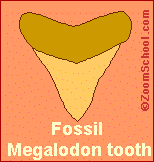EVOLUTION OF SHARKS
Sharks have existed for over 350 million years. They evolved over 100 million years before the dinosaurs did. This was long before people evolved. Most fossil evidence of early sharks is from fossilized teeth. Cladodonts, primitive sharks, had double-pointed teeth, were up to 3 feet (1 m) long fish-eaters and lived about 400 million years ago (mya). Modern forms of sharks evolved during the Jurassic period, about 150 mya.

Shark fossils are rare because sharks have no bones, only cartilage, which does not fossilize well.
Cladoselache
The earliest complete fossil shark,Cladoselache, is from the late Devonian. It had 3-pointed teeth with a large central point and smaller cusps flanking it. It was 1.5-6 feet (0.5-2 m) long and had large spines in front of each of the 2 dorsal fins. It had neither an anal fin nor claspers. There were 5 gill slits on each side of the head. Fossils found in the Cleveland shale include fossilized stomach contents which reveal that it ate crustaceans.
Stethacanthus
A strange-looking shark with brush-like denticles on its head and on a parge protrusion on its back. It had fin spines, an anal fin, and was about 3 feet (1 m) long.
Orthacanthus
Orthacanthus was an ancient, fresh-water shark that had a long spine growing from the back of its skull. It had a very long dorsal fin, which ran all along the sharks back, giving it an eel-like appearance. Order Xenacanthiformes.
Hybodus
An ancient shark from the Carboniferous period, this shark went extinct during the huge K-T mass extinction 65 million years ago, when the dinosaurs died. It had fin spines, an anal fin, and was about 7.5 feet (2.5 m) long.
Megalodon

Megalodon (Carcharodon megalodon) was an ancient, meat-eating shark, living between 5-1.6 million years ago; it is extinct. It was up to 40 feet (12 m) long, but this is only an estimate from fossil teeth that have been found. Its teeth resemble those of the great white shark but are almost 3 times larger.
FOSSILIZED TEETH
 Sharks teeth are the most likely part of its body to fossilize since they're composed of bone. Many fossilized sharks teeth have been found, including that of megalodon. Megalodon (Carcharodon megalodon) was an ancient, meat-eating shark, living between 5-1.6 million years ago; it is extinct. It was up to 40 feet (12 m) long, but this is only an estimate from fossil teeth that have been found. Its teeth resemble those of the great white shark but are almost 3 times larger.
Sharks teeth are the most likely part of its body to fossilize since they're composed of bone. Many fossilized sharks teeth have been found, including that of megalodon. Megalodon (Carcharodon megalodon) was an ancient, meat-eating shark, living between 5-1.6 million years ago; it is extinct. It was up to 40 feet (12 m) long, but this is only an estimate from fossil teeth that have been found. Its teeth resemble those of the great white shark but are almost 3 times larger.
For further information log on website :
http://www.enchantedlearning.com/subjects/sharks/classification/Extinct.shtml
Sharks have existed for over 350 million years. They evolved over 100 million years before the dinosaurs did. This was long before people evolved. Most fossil evidence of early sharks is from fossilized teeth. Cladodonts, primitive sharks, had double-pointed teeth, were up to 3 feet (1 m) long fish-eaters and lived about 400 million years ago (mya). Modern forms of sharks evolved during the Jurassic period, about 150 mya.
Shark fossils are rare because sharks have no bones, only cartilage, which does not fossilize well.
Cladoselache
The earliest complete fossil shark,Cladoselache, is from the late Devonian. It had 3-pointed teeth with a large central point and smaller cusps flanking it. It was 1.5-6 feet (0.5-2 m) long and had large spines in front of each of the 2 dorsal fins. It had neither an anal fin nor claspers. There were 5 gill slits on each side of the head. Fossils found in the Cleveland shale include fossilized stomach contents which reveal that it ate crustaceans.
Stethacanthus
A strange-looking shark with brush-like denticles on its head and on a parge protrusion on its back. It had fin spines, an anal fin, and was about 3 feet (1 m) long.
Orthacanthus
Orthacanthus was an ancient, fresh-water shark that had a long spine growing from the back of its skull. It had a very long dorsal fin, which ran all along the sharks back, giving it an eel-like appearance. Order Xenacanthiformes.
Hybodus
An ancient shark from the Carboniferous period, this shark went extinct during the huge K-T mass extinction 65 million years ago, when the dinosaurs died. It had fin spines, an anal fin, and was about 7.5 feet (2.5 m) long.
Megalodon
Megalodon (Carcharodon megalodon) was an ancient, meat-eating shark, living between 5-1.6 million years ago; it is extinct. It was up to 40 feet (12 m) long, but this is only an estimate from fossil teeth that have been found. Its teeth resemble those of the great white shark but are almost 3 times larger.
FOSSILIZED TEETH
For further information log on website :
http://www.enchantedlearning.com/subjects/sharks/classification/Extinct.shtml





No comments:
Post a Comment